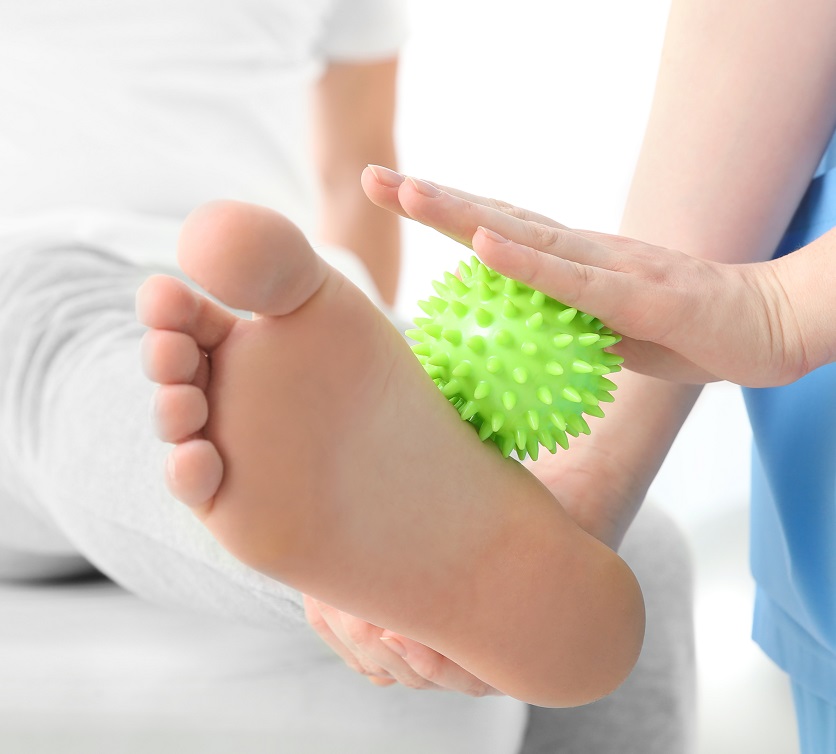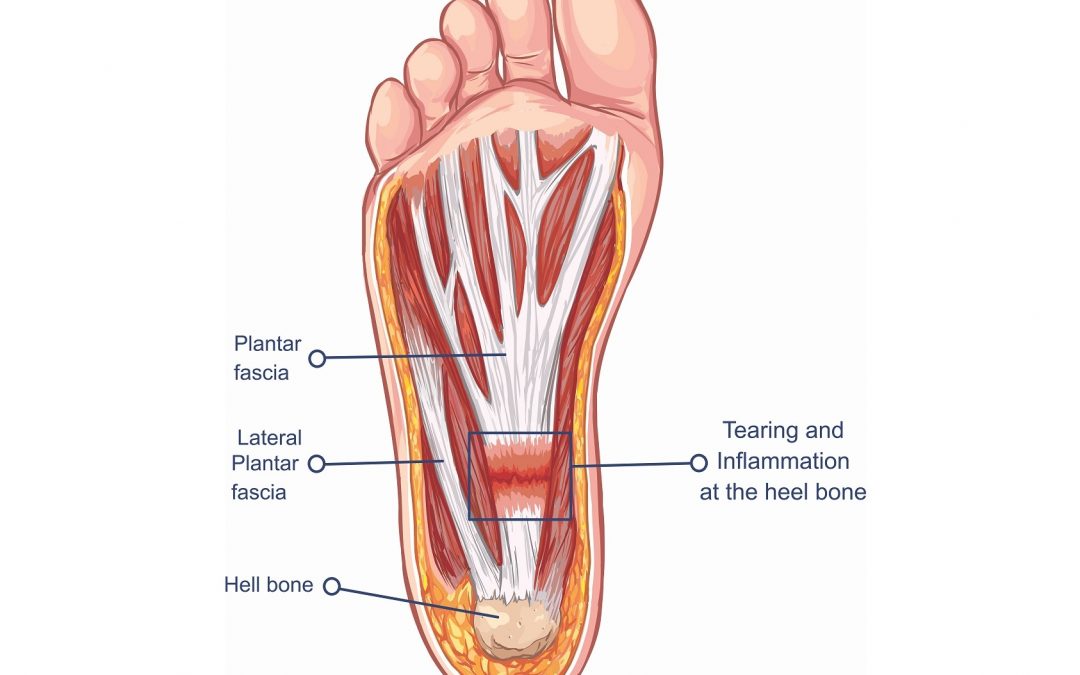Plantar Fasciitis is a painful and uncomfortable condition that causes inflammation of connective tissues and is primarily concentrated in the heel. These connective tissues are part of the plantar fascia, which is a thick ligament located in the arch of the foot and spans from the heel to the toes. What may initially feel like a slight discomfort in the foot, can eventually progress to a stabbing or burning type of pain that makes it intolerable to walk.
While this article will address causes, symptoms and traditional treatment options, a major emphasis will be on addressing the benefits of a high-load strength training program for Plantar Fasciitis.
To demonstrate the impact that plantar fasciitis can have on people’s lives, “The X Brace” presents 10 compelling facts:
Facts About Plantar Fasciitis
- Foot Fact #1: Did you know 1-in-10 people struggle with Plantar Fasciitis at some point in their life? Yup! That’s a lot of people!
- Foot Fact #2: Your Plantar Fascia is incredibly strong! The average amount of stress that is put on your feet for every mile walked is approximately 60 tons.
- Foot Fact #3: 1/4 of all your bones are in your feet and your Plantar Fascia plays a big role in keeping them all supported and in alignment!
- Foot Fact #4: Approximately 1 in 5 people have high arches, which is a common contributor to Plantar Fasciitis.
- Foot Fact #5: Approximately 1 in 4 people have flat feet, which is also a contributor to Plantar Fasciitis.
- Foot Fact #6: The Plantar Fascia is one of the largest ligaments in the body.
- Foot Fact #7: People who are active between the ages of 40 and 70 are the most prone to Plantar Fasciitis.
- Foot Fact #8: Your heel hits the ground roughly 1,500 times for every mile you run.
- Foot Fact #9: Plantar Fasciitis is one of the most common causes of foot pain.
- Foot Fact #10: In many cases, Plantar Fasciitis can be treated in-home.
The human foot is a complex anatomical structure, consisting of 26 bones, 33 joints, and over 100 muscles, tendons, and ligaments.
These interconnected structures are like a finely tuned machine that enable us to stand upright and perform activities that we take for granted, such as walking, climbing, running, and jumping. From a structural perspective, the foot is composed of three main parts, which include the forefoot, midfoot, and hindfoot.
In an examination of the human foot, Matthew Hoffman (MD), highlights each of these parts in the online site WebMD:
Parts of the Foot
- The forefoot contains the five toes (phalzanges) and the five longer bones (metatarsals)
- The midfoot is a pyramid-like collection of bones that form the arches of the feet
- The hindfoot forms the heel and ankle
Clearly, the foot is the most important anatomical part of the human body for balance and distributing weight to the ground, which is why any type of pain or discomfort that emerges in this area can make it difficult to perform daily activities.
For example, if you’re experiencing severe pain in the heel of your foot, chances are you may be developing plantar fasciitis. In this case, the plantar fascia becomes degenerative and sometimes inflamed and leads to irritation or pain in the bottom of your foot. The simple act of walking can be excruciating and may get progressively worse if not given proper treatment.
Being mindful of symptoms associated with plantar fasciitis is the first step toward taking a proactive stance against a debilitating condition that can dramatically impact your quality of life. In Heel That Pain, Noelle Ihli presents a list of symptoms that can signal warning signs of plantar fasciitis, some of which include:
Plantar Fasciitis Symptoms
- Pain that is the worst first thing in the morning, or after a long period of rest
- Aching, sharp, or burning pain in the sole of your foot, often localised in the heel area
- Heel pain that may build gradually, or become apparent suddenly
- Pain that may decrease somewhat as you begin moving around, only to return later in the day
- Swelling, redness, or warmth in the heel area
- Limping and difficulty standing on the affected foot
 Anyone experiencing pain from any of the above symptoms should view this as a sign that seeing a physiotherapist is the best way to determine if you are suffering with plantar fasciitis.
Anyone experiencing pain from any of the above symptoms should view this as a sign that seeing a physiotherapist is the best way to determine if you are suffering with plantar fasciitis.
There are many causes of plantar fasciitis and once you understand your unique situation, you will be better prepared in knowing the best course of action to treat your condition.
In MedicineNet, Dr. William C. Shiel, Jr., states that “Plantar fasciitis is most commonly caused by repetitive strain injury to the ligament of the sole of the foot,” and points to examples such as jumping injury from landing, excessive running or walking, and inadequate foot gear.
Other contributing causes of plantar fasciitis include:
Causes of Plantar Fasciitis
- Very low or high arches
- Being overweight
- Spending long hours on your feet
- Tight calf muscles or tight/stiff ankle muscles
- Walking barefoot in soft sand for long distances
Getting together with your physiotherapist and discussing treatment options for plantar fasciitis provides peace-of-mind, as this is the stage of starting a healing process to eliminate a condition that causes discomfort and pain.
Physiotherapy-treatment points out that traditional treatment options for plantar fasciitis “include stretching the calf, massaging, decreasing one’s training, losing weight, purchasing betting-fitting shoes, icing the sore heel, and taking ibuprofen.”
Even though traditional treatment for plantar fasciitis may bring some relief, incorporating high-load strength training has been shown to be the most successful way to effective reduce symptoms longterm and to prevent the pain returning.
High-Load Strength Training for Plantar Fasciitis
In a highly published study in the Scandinavian Journal of Medicine and Science in Sports, researchers found that patients who did high-load strength training experienced improved outcomes from plantar fasciitis.
 Two groups of patients participated in this study, with the first group being given orthotics and a series of stretching exercises. The second group had been given orthotics without the stretching exercises, and instead followed a high-load strength training protocol.
Two groups of patients participated in this study, with the first group being given orthotics and a series of stretching exercises. The second group had been given orthotics without the stretching exercises, and instead followed a high-load strength training protocol.
After following the high-load strength training protocol for three months, patients from the second group had a significant reduction in pain compared to patients in the first group who only followed the stretching exercises.
Researchers concluded that “High- load strength training may aid in a quicker reduction in pain and improvements in function.” This study confirmed an additional, more effective option for people looking for ways to alleviate pain from plantar fasciitis though high-load strength training.
The process of initiating a high-load strength training protocol is quite simple, given that you can use items already in your home. Doing this routine every other day over a three-month period, resulted in dramatic improvement in patients who participated in this study.
While the results from this study proved the effectiveness of integrating high-load strength training for recovery from plantar fasciitis, it is important to consult with a physiotherapist to determine if this protocol is right for you. Nevertheless, high-load strength training offers an additional option for not only eliminating the pain and discomfort associated with plantar fasciitis, but also providing a path to helping people improve their quality of life.
Sources
- 10 Little Known Facts about Plantar Fasciitis – The X Brace (www.thexbrace.com/blogs/news/10-little-known-facts-about-plantar-fasciitis)
- Picture of the Feet – WebMD (www.webmd.com/pain-management/picture-of-the-feet)
- Plantar Fasciitis – Top Symptoms, Causes, and Treatments (www.heelthatpain.com/plantar-fasciitis)
- Plantar Fasciitis Causes, Symptoms, Treatments, & Exercises (www.medicinenet.com/plantar_fasciitis/article.htm)
- Treatment for Plantar Fasciitis – Physiotherapy Treatment (www.physiotherapy-treatment.com/treatment-for-plantar-fasciitis)
- High-load strength training improves outcome in patients.(www.ncbi.nlm.nih.gov/pubmed/25145882)






